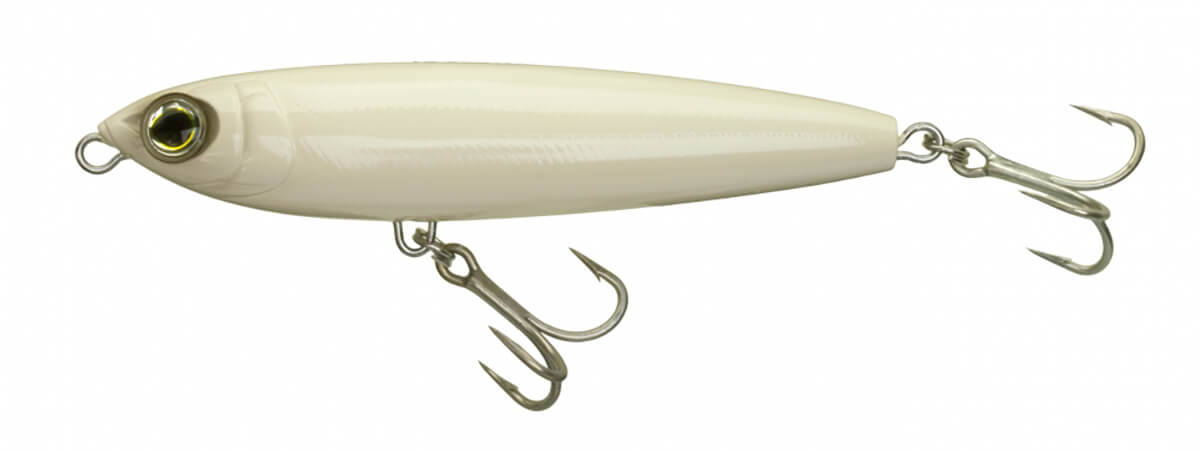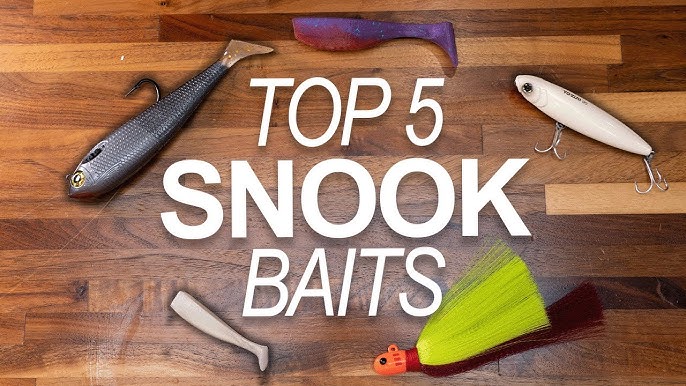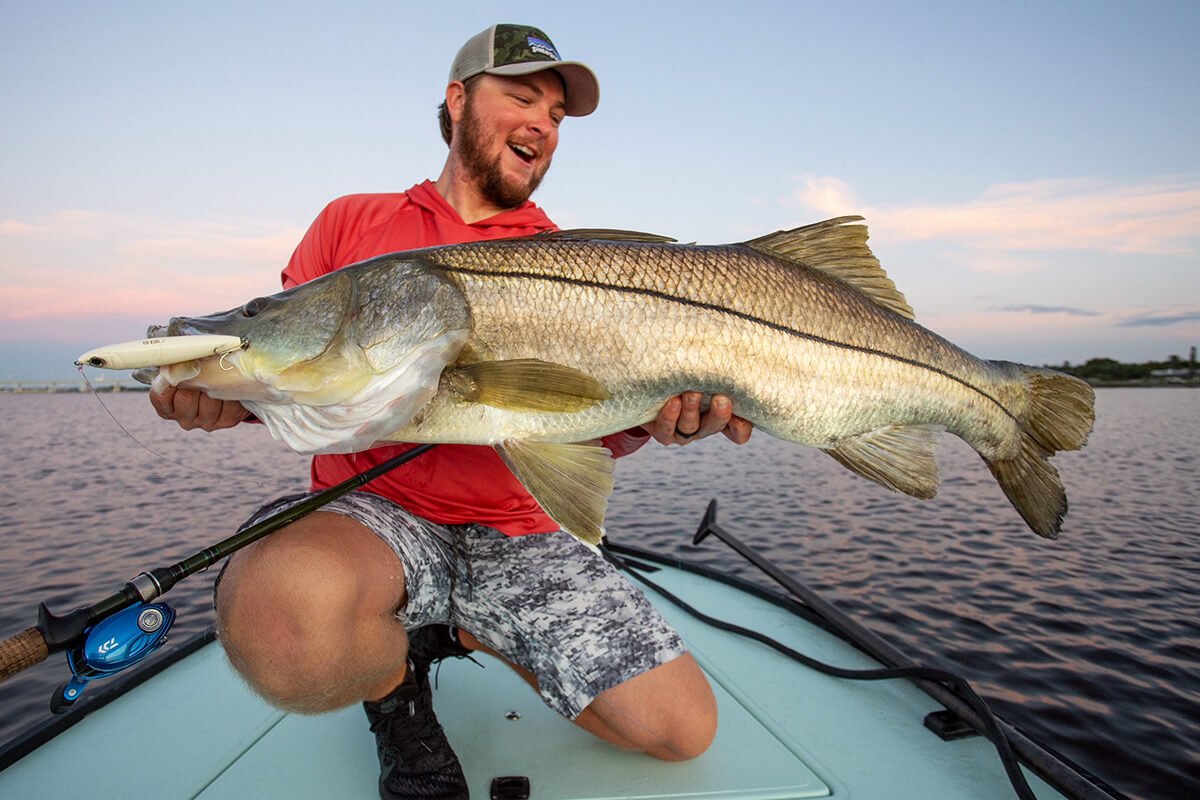Top lures for tarpon include soft plastic swimbaits and live baitfish. For snook, use jigs, spoons, and topwater plugs.
Tarpon and snook fishing offers thrilling experiences for anglers. Choosing the right lure significantly boosts your chances of success. Soft plastic swimbaits mimic baitfish, attracting tarpon effectively. Live baitfish also prove irresistible to tarpon. For snook, jigs provide versatility and can be used in various water conditions.
Spoons create flashy movements, catching snook’s attention. Topwater plugs are perfect for early morning and late evening fishing. Selecting the right lure depends on factors like water clarity, depth, and fish behavior. Understanding these elements ensures a rewarding fishing adventure for both tarpon and snook.
Introduction To Tarpon And Snook Fishing
Tarpon and snook fishing offers thrilling experiences for anglers. These fish are known for their impressive size and acrobatic displays. Understanding their behavior and ideal fishing conditions can increase your chances of success.
Ideal Fishing Conditions
Fishing conditions can greatly affect your success. Here are the best conditions for tarpon and snook fishing:
| Condition | Details |
|---|---|
| Time of Day | Early morning and late evening |
| Water Temperature | Warm waters, around 75-85°F |
| Tide | Outgoing or incoming tides |
| Weather | Calm, clear skies |
Behavior Patterns
Understanding the behavior of tarpon and snook is crucial:
- Tarpon: Known for their high jumps and long runs. They prefer open waters and are often found in coastal areas and bays.
- Snook: These fish are more elusive. They like hiding in mangroves, docks, and bridge pilings. Snook are ambush predators.
Both species are sensitive to water temperature and pressure changes. They are more active during certain times and conditions.
Essential Gear For Tarpon And Snook
When targeting the mighty Tarpon and elusive Snook, having the right gear is crucial. These fish are known for their strength and acrobatics. Proper equipment ensures you can handle the fight and land your catch successfully. Below, we discuss the essential gear for Tarpon and Snook fishing.
Rods And Reels
Choosing the right rod and reel is vital for Tarpon and Snook fishing. You need a rod with enough backbone to handle their power. A medium-heavy to heavy action rod is ideal. It provides the strength needed for these tough fighters.
For reels, a high-quality spinning reel or baitcasting reel is recommended. Look for reels with a strong drag system. This helps manage the intense runs of both Tarpon and Snook. A reel with a high line capacity is also beneficial.
| Rod Type | Ideal Action | Reel Type |
|---|---|---|
| Spinning Rod | Medium-Heavy to Heavy | Spinning Reel |
| Baitcasting Rod | Medium-Heavy to Heavy | Baitcasting Reel |
Fishing Lines
The right fishing line can make a big difference. For Tarpon and Snook, you need a line that is strong and durable. Braided lines are a popular choice due to their high strength and thin diameter.
Fluorocarbon leaders are essential for their abrasion resistance. They help prevent break-offs during the fight. A leader strength of 40-60 pounds is generally recommended.
- Braided Line: High strength, thin diameter.
- Fluorocarbon Leader: Abrasion-resistant, 40-60 pounds.
Having the right gear ensures a successful and enjoyable fishing experience. Invest in quality rods, reels, and lines to tackle these powerful fish.
Top Lures For Tarpon
Tarpon fishing is an exciting adventure. Choosing the right lure can make a big difference. This guide will help you select the best lures for tarpon. We will cover soft plastics and hard baits. These options are proven to attract tarpon effectively.
Soft Plastics
Soft plastics are a favorite among anglers. They are versatile and mimic live bait. Here are some top choices:
- Swimbaits: They have a lifelike swimming action. Use them in clear water.
- Jerkbaits: These work well in shallow waters. They mimic injured fish.
- Soft Shrimp: These lures are perfect for mimicking shrimp. Use them in murky waters.
Hard Baits
Hard baits are durable and effective. They come in various shapes and sizes. Here are some top choices:
- Topwater Plugs: These create surface commotion. Great for early morning fishing.
- Diving Crankbaits: These lures dive deep. Perfect for deeper waters.
- Spoons: Their flashy appearance attracts tarpon. Use them in sunny conditions.
| Type | Best Use |
|---|---|
| Swimbaits | Clear water |
| Jerkbaits | Shallow waters |
| Soft Shrimp | Murky waters |
| Topwater Plugs | Early morning |
| Diving Crankbaits | Deeper waters |
| Spoons | Sunny conditions |

Credit: www.youtube.com
Best Lures For Snook
Fishing for snook is thrilling. Choosing the right lure boosts success. Snook are aggressive predators. They strike with power. Using the best lures increases your catch rate. Here, we discuss the top lures for snook fishing.
Topwater Lures
Topwater lures attract snook effectively. These lures create surface commotion. Snook respond quickly. Popular topwater lures include:
- Poppers: Create splashes and noise.
- Walk-the-dog lures: Mimic injured baitfish.
- Prop baits: Spin and splash for attention.
Use topwater lures in low-light conditions. Early mornings and late evenings are best. Cast near structures like docks and mangroves. Retrieve steadily to mimic prey movement. Watch for explosive strikes!
Jigs
Jigs are versatile and effective for snook. They work in various conditions. Jigs can be used in different water depths. Key types of jigs include:
- Bucktail jigs: Imitate shrimp and baitfish.
- Soft plastic jigs: Offer realistic movement.
- Heavy jigs: Ideal for deeper waters.
Vary jig weights based on current and depth. Use light jigs in shallow areas. Heavy jigs are better for deep channels. Bounce the jig off the bottom. This action mimics fleeing prey. Snook find it irresistible.
| Lure Type | Best For |
|---|---|
| Topwater Lures | Shallow waters, near structures |
| Jigs | Various depths, bottom fishing |
Choosing The Right Lure Color
Understanding how to choose the right lure color can make a big difference when fishing for tarpon and snook. The color of your lure can affect how fish see and react to it. Here, we explore the factors that influence your choice of lure color.
Water Clarity Factors
Water clarity plays a crucial role in selecting the right lure color. In clear water, fish can see more details. Use natural colors like silver, green, and brown. They mimic the baitfish in their environment.
In murky water, use brighter colors. They stand out better. Colors like chartreuse, yellow, and orange are ideal. These colors grab the attention of fish quickly.
| Water Clarity | Recommended Lure Colors |
|---|---|
| Clear Water | Silver, Green, Brown |
| Murky Water | Chartreuse, Yellow, Orange |
Light And Weather Conditions
The light conditions also affect lure color choice. On sunny days, use lighter colors. White, silver, and gold work well. They reflect light and are more visible.
On cloudy days or during dawn and dusk, use darker colors. Black, purple, and blue are effective. They create a better silhouette against the dim light.
- Sunny Days: White, Silver, Gold
- Cloudy Days/Dawn/Dusk: Black, Purple, Blue
Don’t forget to adjust your lure color based on the weather. It can significantly increase your catch rate.
Techniques For Using Tarpon Lures
Using the right techniques can make a huge difference in your tarpon fishing success. Knowing how to properly retrieve and hook your lures will help you catch more tarpon. Below are some essential techniques for using tarpon lures effectively.
Retrieve Methods
Different retrieve methods work for tarpon. The best method depends on the lure and conditions. Here are some common retrieve methods:
- Steady Retrieve: This involves reeling at a constant speed. It’s simple but effective.
- Stop-and-Go: Reel for a few seconds, then pause. This mimics injured prey.
- Jerking Motion: Use quick jerks of the rod. This creates an erratic lure movement.
Experiment with each method. See which one works best for your lure and situation.
Hooking Strategies
Proper hooking is crucial. It increases your chances of landing a tarpon. Here are some effective hooking strategies:
- Circle Hooks: These hooks reduce the chance of gut hooking. They are great for catch-and-release.
- Quick Hook Set: Set the hook quickly once you feel a bite. This helps secure the hook in the fish’s mouth.
- Rod Position: Keep your rod tip down. This helps maintain tension and reduces slack.
Using these strategies can improve your hooking success. Practice them on each trip to perfect your technique.
Techniques For Using Snook Lures
Are you eager to catch more snook? Learning the right techniques for using snook lures can make a big difference. These techniques will increase your chances of landing the big one.
Casting Tips
Effective casting is crucial for snook fishing. Use a sidearm cast to avoid spooking the fish. This method keeps the lure low to the water. Aim for areas with structure, like mangroves or docks. Snook often hide in these spots. Practice makes perfect. The more you cast, the better you get.
Vary your casting distance. Sometimes, short casts work best. Other times, long casts are needed. Experiment to find what works. Be patient and persistent. Casting is an art form that takes time to master.
Reeling Techniques
Reeling in snook requires finesse. Start with a slow, steady retrieve. This mimics a wounded baitfish. Snook can’t resist it. Try adding occasional pauses. This makes the lure look more lifelike. Change your reeling speed to see what triggers a bite.
Bounce the lure off the bottom. This technique works well in deeper waters. Snook often strike when the lure changes direction. Keep your rod tip low for better control. This helps you feel even the slightest nibble.
Remember, snook are smart. They can be picky about their prey. Always be ready to adapt. The key to success is staying versatile and observant.

Credit: www.floridasportsman.com
Common Mistakes To Avoid
Fishing for tarpon and snook can be thrilling. But, many anglers make mistakes. These mistakes can ruin the fishing experience. Knowing common errors can help you catch more fish.
Improper Lure Selection
Choosing the right lure is crucial. Many anglers use the wrong lures. Tarpon and snook have specific preferences. Using the wrong lure can waste time and effort.
- Avoid using lures that are too large.
- Select lures that mimic the prey of tarpon and snook.
- Choose lures with natural colors.
Using the right lure increases your chances of success. Remember to consider the water conditions. Clear water requires different lures than murky water.
Incorrect Retrieval Speed
The speed of your lure retrieval matters. Many anglers retrieve lures too fast or too slow. This can scare away fish or make them lose interest.
| Speed | Effect |
|---|---|
| Too Fast | Scares fish away |
| Too Slow | Fish lose interest |
Adjust your retrieval speed based on the fish behavior. Experiment with different speeds until you find what works. A steady, moderate speed often works best.
Watch the fish’s reaction to your lure. Change your speed if needed. This helps in keeping the fish interested.
Seasonal Considerations
Fishing for tarpon and snook requires understanding their seasonal habits. Different times of the year impact their behavior and location. Knowing these patterns can help you use the best lures effectively.
Best Seasons To Fish
Tarpon and snook have specific seasons when they are most active. This is the time when you have the best chance of a successful catch.
- Spring: Both tarpon and snook are highly active. Warmer waters make them more aggressive.
- Summer: Tarpon migrate to coastal areas. Snook move to the mouths of rivers and estuaries.
- Fall: Snook start to head back to warmer waters. Tarpon begin their journey to deeper waters.
- Winter: Tarpon stay in deeper waters. Snook seek warm, shallow areas like creeks and canals.
Migration Patterns
Understanding migration patterns is crucial for targeting tarpon and snook. These patterns change with the seasons.
| Season | Tarpon Migration | Snook Migration |
|---|---|---|
| Spring | Move towards coastal waters | Migrate to warmer waters, shallow areas |
| Summer | Found in coastal and nearshore waters | Concentrate at river mouths, estuaries |
| Fall | Start moving to deeper waters | Move back towards warmer waters |
| Winter | Stay in deep waters | Seek warm, shallow areas |
By aligning your fishing trips with these patterns, you increase your chances of success. Use the right lures based on the season and location of the fish.
Conclusion And Tips For Success
Fishing for tarpon and snook can be an exhilarating experience. Using the right lures can make a significant difference. Here are some final thoughts and tips for success to help you make the most out of your fishing trips.
Final Thoughts
Choosing the best lures for tarpon and snook involves understanding their habits. Lures that mimic their natural prey will always be more effective. Make sure to adjust your choice based on the water conditions and time of day.
Topwater lures work best during dawn and dusk when fish are more active near the surface. Soft plastics are versatile and can be used in various conditions. Jigs are excellent for targeting snook hiding in deeper waters or around structures.
Remember to always keep an eye on the weather and water conditions. These factors can affect fish behavior and your lure choice.
Additional Resources
For more information on the best lures and techniques, check out these additional resources:
- Fishing Forums: Join fishing forums to discuss with other anglers.
- Local Tackle Shops: Visit local tackle shops for expert advice and the latest gear.
- Fishing Guides: Consider hiring a local fishing guide for personalized tips.
- Online Videos: Watch tutorial videos on YouTube for practical demonstrations.
Utilize these resources to stay updated on the latest trends and techniques in tarpon and snook fishing.

Credit: www.youtube.com
Frequently Asked Questions
What Are The Best Lures For Tarpon?
The best lures for tarpon include soft plastic baits, swimbaits, and topwater plugs. They mimic natural prey and attract tarpon effectively.
Which Lures Work Best For Snook Fishing?
For snook fishing, use jigs, spoons, and soft plastic lures. These lures imitate baitfish and trigger aggressive strikes from snook.
Can I Use The Same Lures For Tarpon And Snook?
Yes, many lures work for both tarpon and snook. Swimbaits and topwater plugs are versatile and effective for both species.
What Color Lures Are Best For Tarpon?
Natural colors like silver, white, and green are best for tarpon. They closely resemble the fish’s natural prey.
Conclusion
Selecting the right lures for tarpon and snook enhances your fishing success. Experiment with different options to find your favorite. Remember, conditions and fish behavior change, so stay adaptable. Happy fishing, and may your next catch be your best yet!

